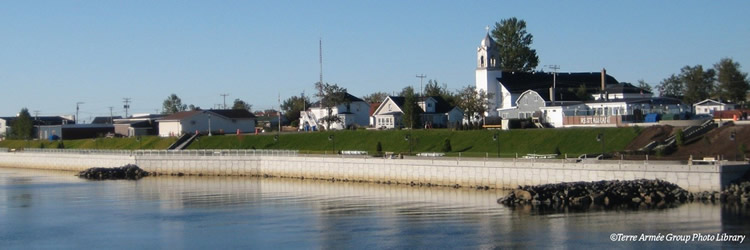By Terre Armée –Situated on the north shore of the Saint Lawrence River in eastern Canada, where the Gulf of St Lawrence opens onto the Atlantic Ocean, the town of Port-Cartier launched a waterfront improvement program to attract shoreline residents and visitors. The seawall construction project was to replace a former timber structure with a Reinforced Earth® system.

The site’s daily tidal fluctuations varied from 1 to 3m, which presented a very challenging condition for the works. Furthermore, project stakeholders wanted to minimize the undesirable view at low tide, so the base of the wall and the riprap toe protection was specified to be as low as feasible.
In total, 1017m² of a 3.5m high Reinforced Earth® GeoMega® wall system was used. The system featured a cruciform precast concrete facing with GeoStrap® soil reinforcements. The polyester strips ensured the best durability in the salt water environment.
GeoStrap® is composed of high-tenacity polyester fibers encased in a polyethylene sheath. The high-tenacity polyester is the load-bearing element, while the sheath protects the yarns from installation damage and degradation. The durability of the polyester strip is increased by the polymerization process, achieving a minimum molecular weight (Mn > 25,000) and low carboxyl end group number (CEG number < 30). GeoStrap® is recommended for use in soil environments characterized by pH lower than 9. Backfills with low electrical resistivity and/or backfills with high chloride or sulfate content have no detrimental effect on GeoStraps. The connection of the reinforcing strip to a precast panel is accomplished by a unique polypropylene sleeve that is cast into the back of the precast facing panel to serve as a recess.
ADAPTED TO MARINE ENVIRONMENTS
The Port-Cartier project represents one of the first uses of a Reinforced Earth® GeoMega® system in a marine and tidal environment in Canada.
To design a wall for submerged conditions, and the rapid draw-down conditions that occur during tidal fluctuations, it is necessary to address both buoyant weight of fill and hydrostatic pressures in the design. The buoyant weight of fill has a couple of effects on the design. The first is the reduction of normal force on the strip, which in turn reduces the frictional resistance that the strip has against pull-out in the design. The second effect is the reduction of lateral earth pressure due to the reduced weight of the backfill in a submerged condition.
Both of these considerations were accounted for in the design.
An additional consideration with even greater effect on wall design is the hydrostatic pressure. The immediate build-up of hydrostatic pressure under draw-down conditions results when the water level outside of the wall recedes quicker than the water level inside the wall volume. On this particular
project, the potential for hydrostatic pressure build-up was eliminated with the use of crushed rock-fill that drains virtually at the same rate as the water outside the wall. This drainage is further accommodated by the panel system having 20mm joints all around that allows the free drainage of the fill without restrictions or the need for drain pipes through panels.
A TIGHT TIMELINE
Port-Cartier is in Northern Quebec where in November/December the weather is already cold. This played a factor in slowing down the seawall construction. The openings of the GeoMega® connectors in the panels had to be covered to prevent rain water from freezing inside and blocking them. Moreover, construction had to be accomplished at low tide to ensure the backfill is placed over the GeoStrap® and panels are secured in place prior to the high tide. In addition it was necessary to start with a large pre-batter of panels and make adjustments according to site conditions in order to maintain a final vertical wall face. Prior experience with Reinforced Earth® walls has proven that these structures can be submerged during the initial stages of construction in sheltered sites or harbors without any damage to the final construction.
A SOLUTION FOR SEAWALL CONSTRUCTION
The Port-Cartier works proved that Reinforced Earth® is a viable solution for seawall construction under difficult climate conditions. The system’s innovative design is appropriate for submerged structures in a saline environment. The provision of a drainage system, an effective erosion protection, and a production schedule that considered the climatic constraints were important factors in the success of this project.
The project highlighted the numerous advantages of using Reinforced Earth® for hydraulic structures and especially for ports and coastal infrastructures.
ABOUT REINFORCED EARTH AND THE TERRE ARMEE GROUP
Drawing on their global expertise and track record, Reinforced Earth® entities under the Terre Armée Group worldwide bring worldwide tailor-made solutions and provide support at all stages of the projects, fulfilling the requirements of marine applications. As a world leader in mechanically stabilized earth, Terre Armée Group has a presence in all five continents and has the advantage of both local and international expertise. This wealth of expertise, has led the company to develop processes offering common advantages:
- Reliable and sustainable materials
- Savings in terms of time and resources
- Capacity to adapt to complex situations
- Integration into the environment, in particular due to an extensive range of panel finishes
Learn more about Terra Armée’s engineering solutions and services, including copper mine crushers, gravity retaining walls, transportation engineering, and much more at www.terre-armee.com.











